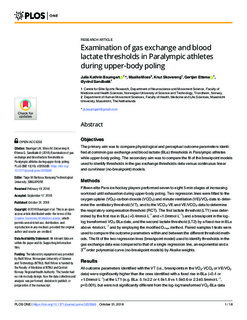| dc.contributor.author | Baumgart, Julia Kathrin | |
| dc.contributor.author | Moes, Maaike | |
| dc.contributor.author | Skovereng, Knut | |
| dc.contributor.author | Ettema, Gertjan | |
| dc.contributor.author | Sandbakk, Øyvind | |
| dc.date.accessioned | 2019-03-11T13:50:56Z | |
| dc.date.available | 2019-03-11T13:50:56Z | |
| dc.date.created | 2019-01-10T15:39:09Z | |
| dc.date.issued | 2018 | |
| dc.identifier.citation | PLoS ONE. 2018, 13 (10), 1-18. | nb_NO |
| dc.identifier.issn | 1932-6203 | |
| dc.identifier.uri | http://hdl.handle.net/11250/2589600 | |
| dc.description.abstract | Objectives
The primary aim was to compare physiological and perceptual outcome parameters identified at common gas exchange and blood lactate (BLa) thresholds in Paralympic athletes while upper-body poling. The secondary aim was to compare the fit of the breakpoint models used to identify thresholds in the gas exchange thresholds data versus continuous linear and curvilinear (no-breakpoint) models.
Methods
Fifteen elite Para ice hockey players performed seven to eight 5-min stages at increasing workload until exhaustion during upper-body poling. Two regression lines were fitted to the oxygen uptake (VO2)-carbon dioxide (VCO2) and minute ventilation (VE)/VO2 data to determine the ventilatory threshold (VT), and to the VCO2-VE and VE/VCO2 data to determine the respiratory compensation threshold (RCT). The first lactate threshold (LT1) was determined by the first rise in BLa (+0.4mmol·L-1 and +1.0mmol·L-1) and a breakpoint in the log-log transformed VO2-BLa data, and the second lactate threshold (LT2) by a fixed rise in BLa above 4mmol·L-1 and by employing the modified Dmax method. Paired-samples t-tests were used to compare the outcome parameters within and between the different threshold methods. The fit of the two regression lines (breakpoint model) used to identify thresholds in the gas exchange data was compared to that of a single regression line, an exponential and a 3rd order polynomial curve (no-breakpoint models) by Akaike weights.
Results
All outcome parameters identified with the VT (i.e., breakpoints in the VO2-VCO2 or VE/VO2 data) were significantly higher than the ones identified with a fixed rise in BLa (+0.4 or +1.0mmol·L-1) at the LT1 (e.g. BLa: 5.1±2.2 or 4.9±1.8 vs 1.9±0.6 or 2.3±0.5mmol·L-1,p<0.001), but were not significantly different from the log-log transformed VO2-BLa data (4.3±1.6mmol·L-1,p>0.06). The outcome parameters identified with breakpoints in the VCO2-VE data to determine the RCT (e.g. BLa: 5.5±1.4mmol·L-1) were not different from the ones identified with the modified Dmax method at the LT2 (5.5±1.1mmol·L-1) (all p>0.53), but were higher compared to parameters identified with VE/VCO2 method (4.9±1.5mmol·L-1) and a fixed BLa value of 4mmol·L-1 (all p<0.03). Although we were able to determine the VT and RCT via different gas exchange threshold methods with good fit in all 15 participants (mean R2>0.931), the continuous no-breakpoint models had the highest probability (>68%) of being the best models for the VO2-VCO2 and the VCO2-VE data.
Conclusions
In Paralympic athletes who exercise in the upper-body poling mode, the outcome parameters identified at the VT and the ones identified with fixed methods at the LT1 showed large differences, demonstrating that these cannot be used interchangeably to estimate the aerobic threshold. In addition, the close location of the VT, RCT and LT2 does not allow us to distinguish the aerobic and anaerobic threshold, indicating the presence of only one threshold in athletes with a disability exercising in an upper-body mode. Furthermore, the better fit of continuous no-breakpoint models indicates no presence of clear breakpoints in the gas exchange data for most participants. This makes us question if breakpoints in the gas exchange data really exist in an upper-body exercise mode in athletes with disabilities. | nb_NO |
| dc.language.iso | eng | nb_NO |
| dc.publisher | Public Library of Science | nb_NO |
| dc.rights | Navngivelse 4.0 Internasjonal | * |
| dc.rights.uri | http://creativecommons.org/licenses/by/4.0/deed.no | * |
| dc.title | Examination of gas exchange and blood lactate thresholds in Paralympic athletes during upper-body poling | nb_NO |
| dc.type | Journal article | nb_NO |
| dc.type | Peer reviewed | nb_NO |
| dc.description.version | publishedVersion | nb_NO |
| dc.source.pagenumber | 1-18 | nb_NO |
| dc.source.volume | 13 | nb_NO |
| dc.source.journal | PLoS ONE | nb_NO |
| dc.source.issue | 10 | nb_NO |
| dc.identifier.doi | 10.1371/journal.pone.0205588 | |
| dc.identifier.cristin | 1654364 | |
| dc.description.localcode | © 2018 Baumgart et al. This is an open access article distributed under the terms of the Creative Commons Attribution License, which permits unrestricte d use, distribu tion, and reproduction in any medium, provided the original author and source are credited. | nb_NO |
| cristin.unitcode | 194,65,30,0 | |
| cristin.unitname | Institutt for nevromedisin og bevegelsesvitenskap | |
| cristin.ispublished | true | |
| cristin.fulltext | original | |
| cristin.qualitycode | 1 | |

